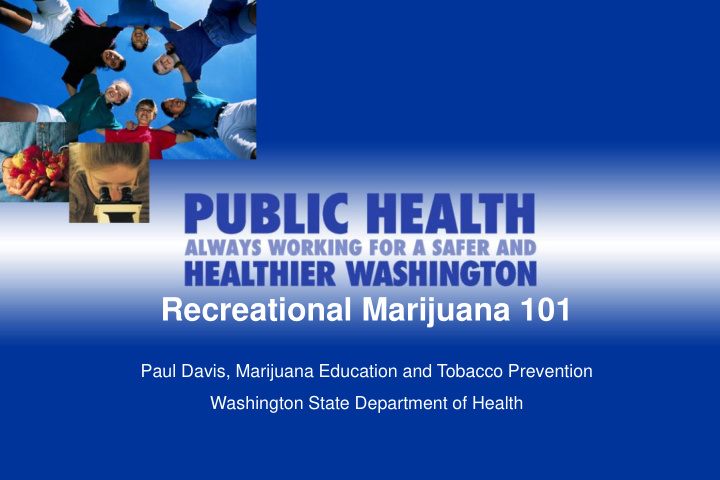



Recreational Marijuana 101 Paul Davis, Marijuana Education and Tobacco Prevention Washington State Department of Health 1
Overview • The Law • DOH Mandates • Today’s Marijuana • Medical Vs. Recreational • Marijuana and Health • Education plans 2
The Law I-502 Marijuana Legalization in Washington State Persons 21 and over can legally purchase, possess and use: • One ounce of useable Marijuana 16 oz. of marijuana infused product in solid form; or 72 oz. of marijuana infused product in liquid form. • It is illegal to drive under the influence of Marijuana THC levels greater than 5 nanograms per milliliter of blood. Blood test must be done to determine THC blood levels (no breath) • It is illegal to consume marijuana in the view of the general public. 3
The Department of Health has 3 mandates for implementing Initiative 502 Marijuana use public health hotline – utilizing evidence based public health approaches – does not advocate an abstinence only approach Media based education campaign – Separately targeting youth and adults Community grants program to prevent/reduce marijuana use by youth.
Department of Health Mission • The Department of Health works to protect and improve the health of people in Washington State. • We will continue to seek connections between marijuana use and health and address the risks as evidence emerges. 5
Today’s Marijuana Methods of Marijuana Consumption • Smoking- most traditional form of ingesting marijuana. • Vaporizing- inhaling active ingredients in marijuana through a vapor instead of smoke. • Edibles- marijuana is infused into foods and/or drinks and are eaten. • Topicals- lotions, salves, balms, and sprays that are applied directly to the skin. • Tinctures- a concentrated form of marijuana in an alcohol solution that can be dropped under tongue. 6
Today’s Marijuana Smokeable Marijuana 7
Today’s Marijuana Vaping 8
Today’s Marijuana Edibles 9
Today’s Marijuana Topicals & Tinctures 10
Today’s Marijuana Advertising 11
Today’s Marijuana Medical vs. Recreational 12
Marijuana and Health What we know at this time… Marijuana is addictive. • There are health consequences associated with marijuana smoke. • There are health risks to infants of mothers who use medical or • recreational marijuana. Driving while under the influence of marijuana is not safe. • Youth marijuana use is associated with higher addiction rates, • lowered IQ, and academic failure. Anxiety, Depression, and existing Mental Health conditions. • Additional concerns: Edibles, E-devices, No regulation of Medical • Market. 13
What “Parents” Should Know Marijuana is Addictive: Most Teens that enter into Treatment Programs in WA • State report that Marijuana is the main or only drug they use. Talk to Your Kids About Marijuana: Teens who use marijuana often start by age • 14. Parents should have ongoing conversations by 4 th or 5 th grade. Express a No Use Attitude: Studies have shown that parents are the #1 influence • in their children's lives. Monitor your Children: Ensure that rules are being followed, remain actively • involved in your child’s life, and know who their friends (and friends parents) are. Monitor your Own Behaviors: You are a role model to your child. Avoid heavy • drinking around your child. Do not use marijuana around your child. 14
Marijuana Use by Grade and Year, WA HYS, 2002-2014 30 27 27 26 25 23 25 22 20 19 19 19 Percent 18 20 18 18 17 15 10 9 9 9 8 10 7 7 5 2 2 2 1 1 1 1 0 Grade 6 Grade 8 Grade 10 Grade 12 15
Marijuana Use by Race/Ethnicity Among 10th Grade Youth, WA HYS, 2014 Hispanic 23 Multiracial* 20 Differences by NH/OPI* 21 race and Asian* 9 ethnicity AIAN* 29 Black* 25 White* 17 0 10 20 30 40 * Non-Hispanic Percent Estimates based all participating schools 16
Youth E-Cigarette Use by Race/Ethnicity Among 10th Grade Youth, WA HYS, 2014 Hispanic 22 Multiracial* 20 NH/OPI* 21 Asian* 9 AIAN* 29 Black* 21 White* 18 0 5 10 15 20 25 30 35 * Non-Hispanic Percent Estimates based on full census of schools 17
Some 2012 data 18
Many youth use more than one substance 19
Marijuana Smoking Among Adults by Race & Hispanic Origin in Washington, 2011-2013 Marijuana Smoking Among Adults by Income as Percent of Federal Poverty Level in Washington, 2011-2013 16 Hispanic 5 14 Pacific Islander* 8 12 Age-Adjusted Percent 10 Asian* 4 8 American Indian/Alaska 6 Native* 6 4 Black* 11 2 * Non- Hispanic White* 10 13 9 8 6 0 ** Insufficient data <$25,000 $25,000- $50,000- $75,000 or 0 5 10 15 20 Source: Washington Behavioral $49,999 $74,999 more Risk Factor Survey Household Income Age-Adjusted Percent ource: Washington Behavioral Risk Factor 20
Next steps: • What are some ways we can reduce substance abuse? • Media campaign • Local coalitions • Policies and community norms 21
What’s next with media campaign? • Depends on funding • Youth focused campaign will be informed by focus groups and other research • Continue campaign to encourage parents and adults to talk to kids about not using • www.starttalkingnow.org 22
Focus Group Findings • Still gaps in knowledge about the law • Scare tactics and ‘most of us’ messages tested poorly • Younger kids think marijuana is more dangerous than older ones • Parents and other adults are a good source of information, as are schools • Sharing trustworthy health impacts can be useful • Many kids don’t want their life experience ‘dulled’ 23
24
Questions or Comments? Paul.Davis@doh.wa.gov (360) 236-3642 25
Recommend
More recommend